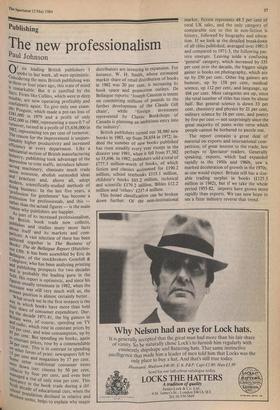Publishing
The new professionalism
Paul Johnson
Of six leading British publishersI spoke to last week, all were optimistic. C. onsidering the mess British publishing was in three or four years ago, this state of mind is remarkable. But it is justified by the facts. Firms like Collins, which were in deep trouble, are now operating profitably and confidently again. To give only one exam- Ple: Penguin, which made a pre-tax loss of £381,000 in 1979 and a profit of only £242,000 in 1980, representing a mere 0.7 o f turnover, turned in a profit of £5,636,000 in 1982, representing ten per cent of turnover. The reason for the improvement is unques- tionably higher productivity and increased efficiency in every department. Like a Substantial section of British manufacturing industry, publishing took advantage of the depression to trim staffs, introduce labour- saving machinery, eliminate much trade union nonsense, abolish outmoded ideas and practices and, above all, adopt Modern, scienticaly-sudie mhods f loIng business.fi Inl thet lastd fiveet years,o a Profession for gentlemen' has become a Profession for professionals, and this rather than the actual figures — is the main reason why publishers are happier.
the Part of its increased professionalism,
'e British book trade now collects, Publishes and studies many more facts abnut itself and its markets and com- petitors. A vast selection of these has been gathered together in The Business of :"°ks: The de Bellaigue Report (Hutch in- 30). It has been assembled by Eric de Bellaigue, of the stockbrokers Grenfell & 2'egrve who has been analysing printing '141 Publishing prospects for two decades fnd is probably the leading guru in the is , and since his ruguresHis usuallyreport terminate inoptimistic 1982, when the Pr
cesslon was still very much with us, the
,cs,Ilt Position is almost certainly better. What at struck me in the first instance is the their In which books have more than held iiteir share of consumer expenditure. Dur- ri tig the decade 1971-81, the big gainers in acid were, of course, spending on TV radio, which rose in constant prices by 8; Per cent, and wine consumption, up by i._ Per co- la. But spending on books, again 1 Constant prices, rose by a commendable Per cent. This is in contrast to spending other forms of print: newspapers fell by Some Per Cent and magazines by 17 per cent. Ceirie other traditional' consumer items toi:e down too: cinema by 50 per cent, nla„aee° by four per cent, and even beer buo"aged a rise of only nine per cent. This YaneY in the book trade during a dif- schult decade of educational cuts, when the aSolute tePrms,i d iv
helps to explain why major
distributors are investing in expansion. For instance, W. H. Smith, whose estimated market share of retail distribution of books in 1982 was 20 per cent, is increasing its book space and promotion outlays. De Bellaigue reports: 'Joseph Causton is intent on committing millions of pounds to the further development of the Claude Gill
represented by'foreign investment Y Classic Bookshops of chain',
Canada is planning an ambitious entry into the industry'.
British publishers turned out 38,980 new books in 1983, up from 24,654 in 1972; in- deed the number of new books published has risen steadily every year except in the disaster year 1981, when it fell from 37,382 to 33,696. In 1982, publishers sold a total of £777.3 million-worth of books, of which fiction and classics accounted for £190.2 million, school textbooks £115.1 million, children's books £63.2 million, technical and scientific £179.2 million, Bibles £12.2 million and 'others' £217.4 million. This broad classification can be broken down further. Of the non-institutional market, fiction represents 48.5 per cent of total UK sales, and the only category of comparable size to this in non-fiction is history, followed by biography and educa- tion. If we look at the detailed breakdown of all titles published, averaged over 1981-3 and compared to 1971-3, the following pat- tern emerges. Leaving aside a confusing 'general' category, which increased by 335 per cent over the decade, the biggest single gainer is books on photography, which are up by 250 per cent. Other big gainers are humour, up by 158 per cent, medical science, up 112 per cent, and language, up 104 per cent. Most categories are up, since the total number of titles has risen by about half. But general science is down 33 per cent, chemistry and physics by 21 per cent, military science by 16 per cent, and poetry by five per cent — not surprisingly since the great majority of poets write verse which people cannot be bothered to puzzle out.
The report contains a great deal of material on exports and international com- petition, of great interest to the trade, less perhaps to Spectator readers. Generally speaking, exports, which had expanded rapidly in the 1950s and 1960s, saw a marked deceleration of growth in the 1970s, as one would expect. Britain still has a size- able trading surplus in books (£125.5 million in 1982), but if we take the whole period 1955-82, imports have grown more rapidly than exports. We can now hope to see a fitter industry reverse that trend.






































 Previous page
Previous page